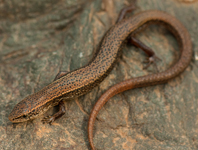Abstract
I describe a new skink of the genus Lobulia from Mt. Simpson in southeasternmost New Guinea. This species differs from all other members of the genus in having only three pairs of enlarged chin shields and only the first pair in medial contact. It is most similar in scalation to L. elegans but is readily distinguished from that species by its color pattern, body size and shape, and numbers of lamellae. Morphological data on L. elegans have not been reported since the description of the holotype in 1897, so I provide a redescription of that species based on six specimens—including the holotype—of certain conspecificity and from within approximately 100 km of the type locality at Mt. Victoria. I also elevate Lygosoma elegantoides lobulus from synonymy with Lobulia elegans, from which it is readily distinguished on the basis of scalational and color-pattern features. The resurrected L. lobulus and the new species from Mt. Simpson represent the seventh and eighth recognized species of Lobulia, and the Mt. Simpson species is the fifth member of the Papuan herpetofauna that is apparently endemic to Mt. Simpson. Mt. Simpson appears to be a moderate center of local endemism within southeastern New Guinea.
References
Ahl, E. (1925) Herpetologische Notizen. Zoologischer Anzeiger, 65, 18–20.
Allison, A. (1980) Distribution and ecology of New Guinea lizards. In Gressitt, J.L. (Ed.), Biogeography and ecology of New Guinea. Dr. W. Junk Publishers, The Hague, pp. 803–813.
https://doi.org/10.1007/978-94-009-8632-9_39
Allison, A. & Greer, A.E. (1986) Egg shells with pustulate surface structures: basis for a new genus of New Guinea skinks (Lactertilia: Scincidae). Journal of Herpetology, 20, 116–119.
https//doi.org/10.2307/1564142
Boulenger, G.A. (1887) Catalogue of the lizards in the British Museum (Natural History). Vol. III. 2nd Edition. Lacertidae, Gerrhosauridae, Scincidae, Anelytropidae, Dibamidae, Chamaeleontidae. British Museum (Natural History), London, 575 pp.
Boulenger, G.A. (1897) Descriptions of new lizards and frogs from Mount Victoria, Owen Stanley Range, New Guinea, collected by Mr. A.S. Anthony. Annals and Magazine of Natural History, Series 6, 19, 6–13.
https://doi.org/10.1080/00222939708680502
Brass, L.J. (1956) Results of the Archbold Expeditions. No.75. Summary of the Fourth Archbold Expedition to New Guinea (1953). Bulletin of the American Museum of Natural History, 111, 77–152.
https://doi.org/10.5962/bhl.title.141745
Greer, A.E. Jr. (1974) The generic relationships of the scincid lizard genus Leiolopisma and its relatives. Australian Journal of Zoology, Supplement Series, 31, 1–67.
https://doi.org/10.1071/AJZS031
Greer, A.E., Allison, A. & Cogger, H.G. (2005) Four new species of Lobulia (Lacertilia: Scincidae) from high altitude in New Guinea. Herpetological Monographs, 19, 153–179.
https://doi.org/10.1655/0733-1347(2005)019[0153:FNSOLL]2.0.CO;2
Kraus, F. (2010) New genus of diminutive microhylid frogs from Papua New Guinea. Zookeys, 48, 39–59.
https://doi.org/10.3897/zookeys.48.446
Kraus, F. (2011) At the lower size limit for tetrapods: two new species of the miniaturized frog genus Paedophryne (Anura: Microhylidae). Zookeys, 154, 71–88.
https://doi.org/10.3897/zookeys.154.1963
Kraus, F. (2016) Ten new species of Oreophryne (Anura, Microhylidae) from Papua New Guinea. Zootaxa, 4195 (1), 1–68.
https://doi.org/10.11646/zootaxa.4195.1.1
Kraus, F. & Allison, A. (2005) A colorful new species of Albericus (Anura: Microhylidae) from southeastern New Guinea. Pacific Science, 59, 43–53.
https://doi.org/10.1353/psc.2005.0008
Kraus, F. & Allison, A. (2006) Three new species of Cophixalus (Anura: Microhylidae) from southeastern New Guinea. Herpetologica, 62, 202–220.
https://doi.org/10.1655/05-09.1
Loveridge, A. (1945) New scincid lizards of the genera Tropidophorus and Lygosoma from New Guinea. Proceedings of the Biological Society of Washington, 58, 47–52.
Mittleman, M.B. (1952) A generic synopsis of the lizards of the subfamily Lygosominae. Smithsonian Miscellaneous Collections, 117, 1–35.
Mys, B. (1988) The zoogeography of the scincid lizards from North Papua New Guinea (Reptilia: Scincidae). I. The distribution of the species. Bulletin de l’Institut Royal des Sciences Naturelles de Belgique, 58, 127–183.
Rodriguez, Z.B., Perkins, S.L. & Austin, C.C. (2018) Multiple origins of green blood in New Guinea lizards. Science Advances, 4, eeao5017.
https://doi.org/10.1126/sciadv.aao5017
Shea, G.M. & Michels, J.P. (1988) A replacement name for Sphenomorphus keiensis (Kopstein, 1926) from the southeastern Moluccas, Indonesia (Reptilia: Sqamata: Scincidae) with a redescription of the species. Zoologische Mededelingen, 82, 737–747.
Smith, M.A. (1937) A review of the genus Lygosoma (Scincidae: Reptilia) and its allies. Records of the Indian Museum, 39, 213–234.
Taylor, E.H. (1936 [1935]) A taxonomic study of the cosmopolitan scincoid lizards of the genus Eumeces with an account of the distribution and relationships of its species. University of Kansas Science Bulletin, 23, 1–643.
https://doi.org/10.2307/1436337
Uetz, P., Freed, P. & Hošek, J. (Eds.) (2019) The Reptile Database. Available from: http://www.reptile-database.org (accessed 15 January 2020)
Zweifel, R.G. (1972) A new scincid lizard of the genus Leiolopisma from New Guinea. Zoologishe Mededelingen, 47, 530–539.
Zweifel, R.G. (1980) Results of the Archbold Expeditions. No. 103. Frogs and lizards from the Huon Peninsula, Papua New Guinea. Bulletin of the American Museum of Natural History, 165, 390–434.


